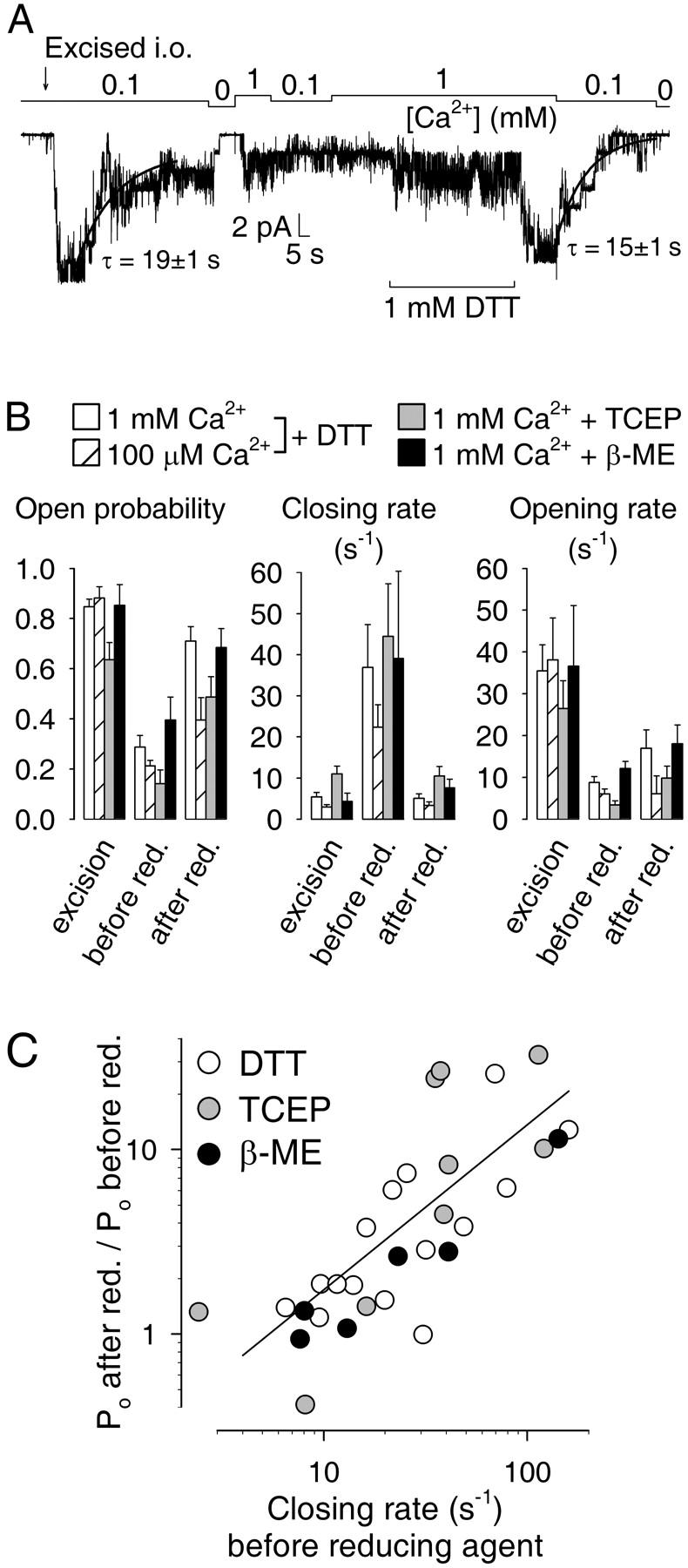FIGURE 9.

Reducing agents reactivate CA-NSC channels after rundown. (A) Current trace from a patch excised (arrow) into 100 μM Ca2+. 1 mM DTT was applied to deactivated channels as indicated (bar). Decay time courses were fitted with single exponentials (solid lines). (B) Comparison of kinetic parameters during deactivation and recovery. Average Po (left panel) closing rates (center panel) and opening rates (right panel) immediately upon excision, after deactivation, and after treatment with reducing agents (groups of bars at left, center, and right of each panel). The effect of treatment on gating was studied both in 1 mM (□) and 100 μM Ca2+ ( ) for DTT, but only in 1 mM Ca2+ for TCEP (
) for DTT, but only in 1 mM Ca2+ for TCEP ( ) and β-ME (▪). Reducing agents were applied at 1 mM with 1 mM Ca2+ present in all cases. (C) Efficiency of reactivation by reducing agents. Fractional elevation of Po after treatment plotted against closing rate before exposure to 1 mM DTT (○), TCEP (
) and β-ME (▪). Reducing agents were applied at 1 mM with 1 mM Ca2+ present in all cases. (C) Efficiency of reactivation by reducing agents. Fractional elevation of Po after treatment plotted against closing rate before exposure to 1 mM DTT (○), TCEP ( ), or β-ME (•), all in 1 mM Ca2+. (Solid line) Linear regression to the log-log plot. Numbers of experiments and statistics: n = 15, 8, 11, and 6, respectively, for DTT (1 mM Ca2+), DTT (100 μM Ca2+), TCEP, and β-ME. After DTT treatment, Po increased significantly both in 1 mM Ca2+ (p < 0.00001) and in 100 μM Ca2+ (p = 0.07), but remained significantly smaller than immediately upon excision (p = 0.04 and p = 0.0004, respectively). Closing rate of deactivated channels, both in 1 mM and 100 μM Ca2+, was significantly reduced by DTT (p = 0.005, and p = 0.004) and became indistinguishable from immediate post-excision values (p = 0.83 and p = 0.68). Opening rate of deactivated channels after DTT treatment was somewhat elevated in 1 mM Ca2+ (p = 0.08), but not in 100 μM Ca2+ (p = 0.997). TCEP or β-ME treatment both significantly stimulated Po of deactivated channels (p = 0.002 and p = 0.04), and both reduced closing rates to immediate post-excision values (p = 0.88 and p = 0.29).
), or β-ME (•), all in 1 mM Ca2+. (Solid line) Linear regression to the log-log plot. Numbers of experiments and statistics: n = 15, 8, 11, and 6, respectively, for DTT (1 mM Ca2+), DTT (100 μM Ca2+), TCEP, and β-ME. After DTT treatment, Po increased significantly both in 1 mM Ca2+ (p < 0.00001) and in 100 μM Ca2+ (p = 0.07), but remained significantly smaller than immediately upon excision (p = 0.04 and p = 0.0004, respectively). Closing rate of deactivated channels, both in 1 mM and 100 μM Ca2+, was significantly reduced by DTT (p = 0.005, and p = 0.004) and became indistinguishable from immediate post-excision values (p = 0.83 and p = 0.68). Opening rate of deactivated channels after DTT treatment was somewhat elevated in 1 mM Ca2+ (p = 0.08), but not in 100 μM Ca2+ (p = 0.997). TCEP or β-ME treatment both significantly stimulated Po of deactivated channels (p = 0.002 and p = 0.04), and both reduced closing rates to immediate post-excision values (p = 0.88 and p = 0.29).
